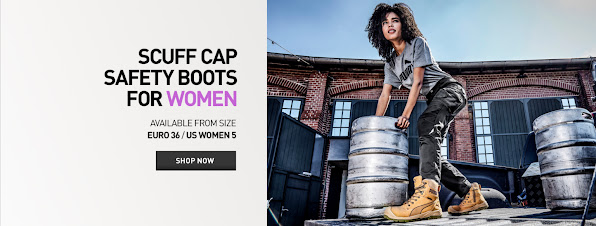What is considered a “Safety Shoe” for Men and Women?
In the dynamic world of industrial work, safety is
paramount. Ensuring the well-being of employees on the job is not only a legal
requirement but also an ethical responsibility. Central to this effort is the
provision of appropriate safety footwear. However, with the plethora of options
available in the market, it can be challenging to discern what truly
constitutes a "safety shoe" for both men and women. Let's delve into
the essential features and considerations that define a safety shoe, catering
to the diverse needs of today's workforce.
1.
Protective Toe Cap:
One of the hallmark features of safety shoes is the presence
of a protective toe cap. Traditionally made of steel, these caps are designed
to safeguard the wearer's toes from heavy objects or compression. However,
advancements in materials have led to the emergence of composite and alloy toe
caps, offering comparable protection with reduced weight and enhanced comfort.
For women, safety
shoes with toe caps specifically tailored to the contours of the
female foot are increasingly available, ensuring both protection and a
comfortable fit.
2. Slip
Resistance:
Work environments often entail slippery surfaces, increasing
the risk of accidents. A quality safety shoe should possess excellent slip
resistance, providing traction and stability to prevent slips and falls. This
feature is particularly crucial for individuals working in sectors such as
hospitality, healthcare, and manufacturing, where spills and wet surfaces are
commonplace. Look for safety shoes with outsoles engineered from slip-resistant
materials and innovative tread designs to maximize grip.
3.
Electrical Hazard Protection:
In occupations where exposure to electrical hazards is a
concern, men's work safety shoes with
electrical hazard (EH) protection are indispensable. These shoes are equipped
with insulation to minimize the flow of electricity through the footwear,
reducing the risk of electric shock. EH-rated safety shoes undergo rigorous
testing to ensure they meet industry standards for electrical hazard
resistance, offering peace of mind to workers in electrically charged
environments.
4.
Impact Resistance:
Beyond toe protection, safety shoes should also provide
adequate protection against impacts to the foot. This includes features such as
reinforced heel counters and metatarsal guards, which shield vulnerable areas
of the foot from falling or rolling objects. For women, manufacturers are
increasingly incorporating these protective elements into safety boots designed
specifically to accommodate the anatomical nuances of the female foot, ensuring
both safety and comfort.
5.
Comfort and Fit:
While prioritizing safety features is essential, comfort
should not be overlooked. Workers spend prolonged hours on their feet, making
comfort a crucial consideration in selecting safety footwear. Look for shoes
with cushioned insoles, breathable linings, and ergonomic designs that promote
proper posture and reduce fatigue. Additionally, ensuring a proper fit is vital
to prevent discomfort and foot-related issues. Many brands offer a range of
sizes and widths to accommodate diverse foot shapes, ensuring that both men and
women can find safety shoes that fit comfortably.
6.
Stylish Design Options:
Gone are the days when safety shoes were solely utilitarian
in appearance. Today, manufacturers recognize the importance of blending safety
with style, offering a plethora of design options to cater to varied
preferences. From athletic-inspired sneakers to classic work boot designs,
there's a safety shoe to suit every taste. For women, this means access to
safety footwear that not only provides the necessary protection but also
complements their personal style, empowering them to feel confident and secure
on the job.
A "safety shoe" for both men and women encompasses
a range of features designed to protect against workplace hazards while prioritizing
comfort and style. By selecting footwear that incorporates protective elements
such as toe caps, slip resistance, electrical hazard protection, and impact
resistance, workers can mitigate the risk of injuries and ensure their
well-being on the job. With an array of options available in the market,
finding the perfect safety shoe is easier than ever, empowering individuals to
work safely and confidently in any environment.



Comments
Post a Comment